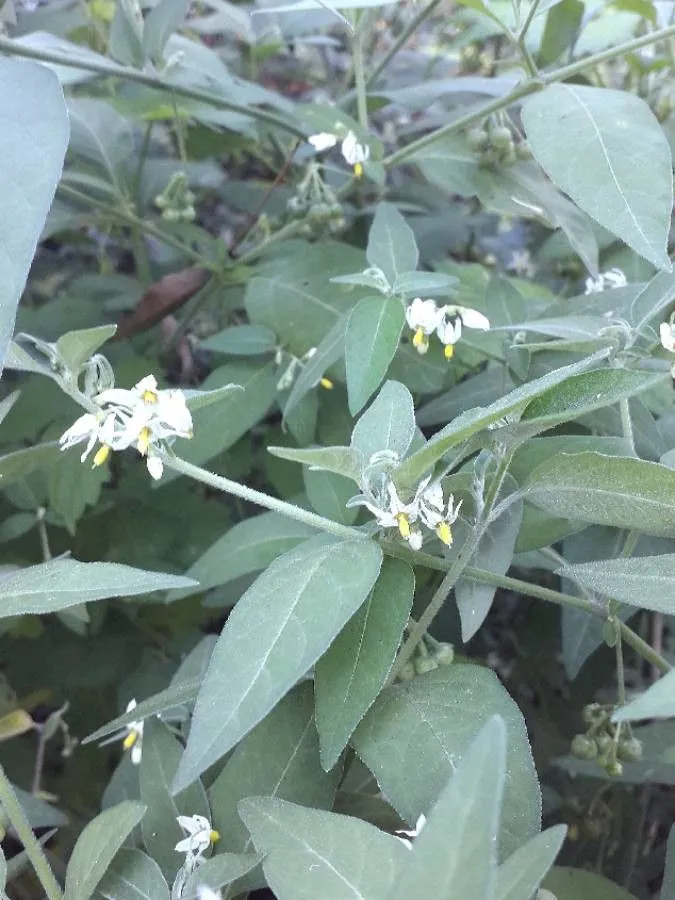
Author: Lam.
Bibliography: Tabl. Encycl. 2: 18 (1794)
Year: 1794
Status: accepted
Rank: species
Genus: Solanum
Vegetable: Unknown
Observations: Bolivia to Brazil and Argentina
The Tall nightshade, scientifically known as Solanum chenopodioides, is a fascinating plant belonging to the Solanaceae family, a group well-known for its diverse and economically important species. First described in 1794 in the Tabl. Encycl. by the botanist Lamarck, this species has captured the interest of botanists and plant enthusiasts alike.
Native to the South American regions extending from Bolivia and Brazil to Argentina, Tall nightshade thrives in a variety of habitats. This adaptability across such a wide geographical range showcases the plant’s resilience and ecological versatility. It can often be found in open fields, along roadsides, and in disturbed areas, flourishing in both natural and human-influenced environments.
The plant is easily recognizable by its distinct physical characteristics. It typically grows erect, reaching considerable heights, which accounts for its common name. Its foliage has a unique texture, and the leaves bear a resemblance to those of the Chenopodium genus, hence the specific epithet ‘chenopodioides.’
Tall nightshade is also notable for its flowering and fruiting patterns. The flowers are small and white to light purple, arranged in clusters. They eventually give way to small, round berries that change color as they mature, often from green to various hues of purple or black.
While the Tall nightshade has ornamental value and contributes to local ecosystems by providing food for various insects and animals, it is important to handle it with care. As with many members of the Solanaceae family, certain parts of the plant can be toxic if ingested in large quantities.
Overall, Solanum chenopodioides is a plant of both beauty and significance. Its ability to thrive across numerous South American locales and its characteristic features make it an intriguing subject of study in both botanical and ecological circles.
Deu: gänsefuß-nachtschatten, zierlicher nachtschatten
Spa: yerbamora vellosa
Eng: tall nightshade
Swe: filtnattskatta
Cym: codwarth tal
En: Tall nightshade, Whitetip nightshade, Velvety nightshade, Goosefoot Nightshade
Fr: Morelle faux chénopode, Morelle grêle, Morelle sublobée
De: Zierlicher Nachtschatten, Gänsefuß-Nachtschatten
It: Morella gracile
Es: Yerbamora vellosa
Sv: Filtnattskatta
Cy: Codwarth tal
Taken Jul 21, 2017 by Fejul Xeto (cc-by-sa)
Taken Sep 29, 2018 by Creu Lopez (cc-by-sa)
Taken Sep 29, 2018 by Creu Lopez (cc-by-sa)
Taken Sep 29, 2018 by Creu Lopez (cc-by-sa)
Taken Sep 29, 2018 by Creu Lopez (cc-by-sa)
Taken Oct 28, 2019 by Denise de Lassat (cc-by-sa)
Taken Sep 21, 2021 by Villaronga Lorenzo Lois Antón (cc-by-sa)
Taken Oct 5, 2020 by Prieta Javier (cc-by-sa)
Taken Jul 21, 2017 by Fejul Xeto (cc-by-sa)
Taken Sep 29, 2018 by Creu Lopez (cc-by-sa)
© copyright of the Board of Trustees of the Royal Botanic Gardens, Kew.
© copyright of the Board of Trustees of the Royal Botanic Gardens, Kew.
© copyright of the Board of Trustees of the Royal Botanic Gardens, Kew.
Taken Sep 8, 2019 by Edion Petriti (cc-by-sa)
Taken Jun 7, 2022 by Ata Karamouzian (cc-by-sa)
Taken Sep 28, 2016 by Tela Botanica − Florent BECK (cc-by-sa)
Taken Mar 4, 2020 by Akash kharel (cc-by-sa)
Taken Jul 21, 2017 by Fejul Xeto (cc-by-sa)
Taken Oct 24, 2015 by Tela Botanica − Liliane ROUBAUDI (cc-by-sa)
Taken Oct 24, 2015 by Tela Botanica − Liliane ROUBAUDI (cc-by-sa)
Taken Jun 25, 2014 by Tela Botanica − Yoan MARTIN (cc-by-sa)
Taken Oct 24, 2015 by Tela Botanica − Liliane ROUBAUDI (cc-by-sa)
Taken Jul 22, 2017 by jacques chavaribeyre (cc-by-sa)
Taken Aug 29, 2013 by Tela Botanica − Marie PORTAS (cc-by-sa)
Taken Oct 24, 2015 by Tela Botanica − Liliane ROUBAUDI (cc-by-sa)
Taken Feb 9, 2016 by Tela Botanica − David RENOULT (cc-by-sa)
Taken Oct 24, 2015 by Tela Botanica − Liliane ROUBAUDI (cc-by-sa)
Taken Sep 23, 2015 by Tela Botanica − Florent BECK (cc-by-sa)
Taken Oct 4, 2018 by Meiga Entropía (cc-by-sa)
Taken Feb 22, 2019 by plusminus (cc-by-sa)
Taken Jun 12, 2020 by Perles Miguel (cc-by-sa)
Taken Oct 24, 2015 by Tela Botanica − Liliane ROUBAUDI (cc-by-sa)
Family: Myrtaceae Author: (F.Muell.) K.D.Hill & L.A.S.Johnson Bibliography: Telopea 6: 402 (1995) Year: 1995 Status:…
Family: Rubiaceae Author: Pierre ex A.Froehner Bibliography: Notizbl. Bot. Gart. Berlin-Dahlem 1: 237 (1897) Year:…
Family: Sapindaceae Author: Koidz. Bibliography: J. Coll. Sci. Imp. Univ. Tokyo 32(1): 38 (1911) Year:…
Family: Asteraceae Author: A.Gray Bibliography: Pacif. Railr. Rep.: 107 (1857) Year: 1857 Status: accepted Rank:…
Family: Fabaceae Author: Medik. Bibliography: Vorles. Churpfälz. Phys.-Ökon. Ges. 2: 398 (1787) Year: 1787 Status:…
Family: Aspleniaceae Author: (Cav.) Alston Bibliography: Bull. Misc. Inform. Kew 1932: 309 (1932) Year: 1932…